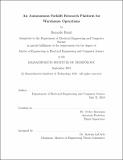| dc.contributor.advisor | Sertac Karaman. | en_US |
| dc.contributor.author | Baird, Renardo. | en_US |
| dc.contributor.other | Massachusetts Institute of Technology. Department of Electrical Engineering and Computer Science. | en_US |
| dc.date.accessioned | 2019-07-15T20:28:40Z | |
| dc.date.available | 2019-07-15T20:28:40Z | |
| dc.date.copyright | 2018 | en_US |
| dc.date.issued | 2018 | en_US |
| dc.identifier.uri | https://hdl.handle.net/1721.1/121621 | |
| dc.description | This electronic version was submitted by the student author. The certified thesis is available in the Institute Archives and Special Collections. | en_US |
| dc.description | Thesis: M. Eng., Massachusetts Institute of Technology, Department of Electrical Engineering and Computer Science, 2018 | en_US |
| dc.description | Cataloged from student-submitted PDF version of thesis. | en_US |
| dc.description | Includes bibliographical references (pages 45-46). | en_US |
| dc.description.abstract | Autonomous vehicle technology has seen transformative change over the past decade, enabling products such as autonomous automobiles. In the field of warehouse automation, autonomous vehicles have a long history, with automatic guided vehicles (AGVs) existing since the 1950s. Early vehicles were inflexible and relied on costly infrastructure. However, advances in technology have enabled a much greater level of sophistication. Yet, currently only 16% of companies operating warehouses make use of AGVs. Additionally, modern AGVs available today, while quite sophisticated, are still relatively inflexible and costly. In this project, we develop a prototype forklift AGV research platform capable of operation in an indoor warehouse environment. The aim of the project is to provide researchers with a vehicle platform with which to experiment with advanced autonomy and push the boundaries of AGV capability. The vehicle is a fully functional 3-wheel counterbalance fork truck with 4000lb load capacity. The vehicle is equipped with cameras, laser scanners, an IMU and a powerful onboard computer. A reference software implementation is also developed and tested, which allows a base level of full autonomy, enabling the vehicle to perform autonomous pick and place tasks. In it's role as a research platform, it is anticipated that the vehicle will enable investigation into research areas such as fully autonomous operation using inexpensive sensors, manipulation of overhead loads, operation in unstructured cluttered environments, and operation in collaboration with human operators. | en_US |
| dc.description.statementofresponsibility | by Renardo Baird. | en_US |
| dc.format.extent | 46 pages | en_US |
| dc.language.iso | eng | en_US |
| dc.publisher | Massachusetts Institute of Technology | en_US |
| dc.rights | MIT theses are protected by copyright. They may be viewed, downloaded, or printed from this source but further reproduction or distribution in any format is prohibited without written permission. | en_US |
| dc.rights.uri | http://dspace.mit.edu/handle/1721.1/7582 | en_US |
| dc.subject | Electrical Engineering and Computer Science. | en_US |
| dc.title | An autonomous forklift research platform for warehouse operations | en_US |
| dc.type | Thesis | en_US |
| dc.description.degree | M. Eng. | en_US |
| dc.contributor.department | Massachusetts Institute of Technology. Department of Electrical Engineering and Computer Science | en_US |
| dc.identifier.oclc | 1098045700 | en_US |
| dc.description.collection | M.Eng. Massachusetts Institute of Technology, Department of Electrical Engineering and Computer Science | en_US |
| dspace.imported | 2019-07-15T20:28:38Z | en_US |
| mit.thesis.degree | Master | en_US |
| mit.thesis.department | EECS | en_US |
